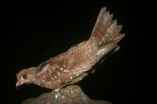(Press-News.org) In the midst of today's global extinction crisis, decisions about conservation should include prioritizing how best to preserve as much of the tree of life as possible. So say researchers who report in the Cell Press journal Current Biology on the first application of an approach to identify the most evolutionarily distinct of the world's 9,993 bird species.
At the very top of their list of the most evolutionary distinct birds is the South American oilbird, which represents almost 80 million years of evolution shared with no other bird on the planet.
"Evolutionary distinctness is a metric that informs about the loss of evolutionary information that the extinction of a given species would cause," says Walter Jetz of Yale University. "Among very closely related species, we would expect a lot of genetic redundancy. If there is only one of a kind, say an oilbird, and it were to go extinct, all of the information on how to make and be that species would be lost forever. Thanks to global family trees, we are able to now compare this aspect of distinctness for all species, something that due to lack of data is not possible for any other characteristics."
"Evolutionary distinctness helps us identify those species we cannot afford to lose," says coauthor Dave Redding of University College London.
In the new report, the researchers performed the first fully quantitative, phylogenetically and geographically integrated conservation assessment for birds all around the world. Evolutionary distinctness was quantified for each species based on how isolated it is on the family tree of all birds. The most evolutionarily distinct species are those with the fewest connections and the longest branches separating them from other parts of the tree.
The researchers report that world's top 50 most evolutionarily distinct bird species include widely distributed and common species such as the osprey and the ostrich, well-known oddities such as the hoatzin and the shoebill, and lesser-known, range-restricted species such as the New Caledonian owlet-nightjar and the Solomon Islands frogmouth, the researchers report. The list also includes the South American oilbird and the cuckoo roller of Madagascar, which are both separated from the rest of the avian tree of life by more than 65 million years.
The researchers then used that information to calculate a new species metric, "evolutionary distinctness rarity," or EDR, which relates a species' evolutionary distinctness to the size of its breeding area. Top EDR species include the Christmas Island frigatebird and the kakapo of New Zealand. These are species with large evolutionary information concentrated in very small areas, i.e. cases where even localized disturbance or conservation action could have a large effect on the tree of life.
Although decisions about how to triage the conservation of species are always difficult, they are nevertheless necessary, says Arne Mooers, a coauthor at Simon Fraser University. The new study shows that use of distinctness measures can provide an objective, effective, and economical way to protect evolutionary diversity. This approach may be particularly useful because information about relationships among species is often much easier to come by than detailed ecological assessments, and evolutionarily distinct species can often be found in places that aren't well known as hot spots for biodiversity.
"In the face of global change and limited resources, integration of growing spatial and phylogenetic biodiversity information holds promise for effectively and economically meeting societal biodiversity conservation targets," the researchers conclude.
INFORMATION:
Current Biology, Jetz et al.: "Global distribution and conservation of evolutionary distinctness in birds."
Use Map of Life (http://www.mol.org/) – a web resource for geographic biodiversity discovery and education - to explore the evolutionary most distinct species: species.mol.org/info. For example, the Giant Ibis or the Oilbird. END
Genetic distinctness to guide global bird conservation
2014-04-10
ELSE PRESS RELEASES FROM THIS DATE:
Researchers find that influenza has an Achilles' heel
2014-04-10
Flu epidemics cause up to half a million deaths worldwide each year, and emerging strains continually threaten to spread to humans and cause even deadlier pandemics. A study published by Cell Press on April 10 in the journal Immunity reveals that a drug that inhibits a molecule called prostaglandin E2 (PGE2) increases survival rates in mice infected with a lethal dose of the H1N1 flu virus. The findings pave the way for an urgently needed therapy that is highly effective against the flu virus and potentially other viral infections.
"Drugs that specifically target PGE2 ...
Team solves decades-old mystery of how cells keep from bursting
2014-04-10
LA JOLLA, CA—April 10, 2014—A team led by scientists at The Scripps Research Institute (TSRI) has identified a long-sought protein that facilitates one of the most basic functions of cells: regulating their volume to keep from swelling excessively.
The identification of the protein, dubbed SWELL1, solves a decades-long mystery of cell biology and points to further discoveries about its roles in health and disease—including a serious immune deficiency that appears to result from its improper function.
"Knowing the identity of this protein and its gene opens up a broad ...
Lactate metabolism target halts growth in lung cancer model
2014-04-10
BOSTON – Cancer cells generate energy differently than normal cells, a characteristic that helps them to survive and metastasize. A major goal in the field of cancer metabolism is to find ways to overcome this survival advantage.
Now a research team led by investigators in the Cancer Center at Beth Israel Deaconess Medical Center (BIDMC) has found that targeting the enzyme responsible for the final step of glucose metabolism not only halts tumor growth in non-small-cell lung cancer, but actually leads to the regression of established tumors.
Importantly, the new findings, ...
Getting to the root of Parkinson's disease
2014-04-10
Working with human neurons and fruit flies, researchers at Johns Hopkins have identified and then shut down a biological process that appears to trigger a particular form of Parkinson's disease present in a large number of patients. A report on the study, in the April 10 issue of the journal Cell, could lead to new treatments for this disorder.
"Drugs such as L-dopa can, for a time, manage symptoms of Parkinson's disease, but as the disease worsens, tremors give way to immobility and, in some cases, to dementia. Even with good treatment, the disease marches on," says ...
Too much protein may kill brain cells as Parkinson's progresses
2014-04-10
Scientists may have discovered how the most common genetic cause of Parkinson's disease destroys brain cells and devastates many patients worldwide. The study was partially funded by the National Institutes of Health's National Institute of Neurological Disorders and Stroke (NINDS); the results may help scientists develop new therapies.
"This may be a major discovery for Parkinson's disease patients," said Ted Dawson, M.D., Ph.D., director of the Johns Hopkins University (JHU) Morris K. Udall Center of Excellence for Parkinson's Disease, Baltimore, MD. Dr. Dawson and ...
Researchers determine how mechanical forces affect T-cell recognition and signaling
2014-04-10
T-cells are the body's sentinels, patrolling every corner of the body in search of foreign threats such as bacteria and viruses. Receptor molecules on the T-cells identify invaders by recognizing their specific antigens, helping the T-cells discriminate attackers from the body's own cells. When they recognize a threat, the T-cells signal other parts of the immune system to confront the invader.
These T-cells use a complex process to recognize the foreign pathogens and diseased cells. In a paper published this week in the journal Cell, researchers add a new level of understanding ...
Researchers identify transcription factors distinguishing glioblastoma stem cells
2014-04-10
The activity of four transcription factors – proteins that regulate the expression of other genes – appears to distinguish the small proportion of glioblastoma cells responsible for the aggressiveness and treatment resistance of the deadly brain tumor. The findings by a team of Massachusetts General Hospital (MGH) investigators, which will be published in the April 24 issue of Cell and are receiving advance online release, support the importance of epigenetics – processes controlling whether or not genes are expressed – in cancer pathology and identify molecular circuits ...
Yale researchers search for earliest roots of psychiatric disorders
2014-04-10
Newborns whose mothers were exposed during pregnancy to any one of a variety of environmental stressors — such as trauma, illness, and alcohol or drug abuse — become susceptible to various psychiatric disorders that frequently arise later in life. However, it has been unclear how these stressors affect the cells of the developing brain prenatally and give rise to conditions such as schizophrenia, post-traumatic stress disorder, and some forms of autism and bipolar disorders.
Now, Yale University researchers have identified a single molecular mechanism in the developing ...
Some birds come first -- a new approach to species conservation
2014-04-10
New Haven, Conn.— A Yale-led research team has developed a new approach to species conservation that prioritizes genetic and geographic rarity and applied it to all 9,993 known bird species.
"To date, conservation has emphasized the number of species, treating all species as equal," said Walter Jetz, the Yale evolutionary biologist who is lead author of a paper published April 10 in Current Biology. "But not all species are equal in their genetic or geographic rarity. We provide a framework for how such species information could be used for prioritizing conservation."
Worldwide, ...
Penn study finds mechanism that regulates lung function in disease Birt-Hogg-Dube syndrome
2014-04-10
(PHILADELPHIA) – Researchers at Penn Medicine have discovered that the tumor suppressor gene folliculin (FLCN) is essential to normal lung function in patients with the rare disease Birt-Hogg-Dube (BHD) syndrome, a genetic disorder that affects the lungs, skin and kidneys. Folliculin's absence or mutated state has a cascading effect that leads to deteriorated lung integrity and an impairment of lung function, as reported in their findings in the current issue of Cell Reports.
"We discovered that without normal FLCN the alveolar epithelial cells (AEC) in these patients' ...


